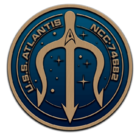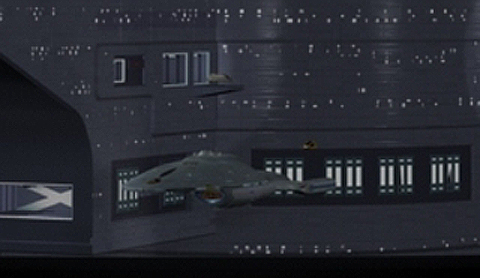Atlantis Statistics
Statistics
- Name: USS Atlantis
- Registry: NCC-74682
- Class: Intrepid class Light Explorer
- Commissioned: Commander Varaan
Hull Specifications
- Height: 66.35m
- Width: 133.42m
- Length: 344.42m
- Number of Decks: 15
Personnel Systems
- Complement: 150
- Officers: 50
- Enlisted: 100
- Passengers: 65
- Evacuation Capacity: max 3550
- Crew Quarters:
- Spartan: None
- Basic: 250
- Expanded: 30
- Luxury: 5
- Unusual: 2
- Environmental Systems:
- Emergency Life Support (36 emergency shelters)
- Consumables: 3 years' worth
- Replicators: Food network, and Industrial
- Medical: Standard Sickbay, EMH mark III
- Recreation Facilities: Holodecks (2), gymnasium, lounges
- Personnel transport: turbolift network, Jeffries tubes
- Cargo:
- Capacity: 66,000 metric tonnes, Cargo Bays 1-4 (deck 8)
- Escape Pods: 140 8-person pods
Propulsion
- Warp Nacelles: 2 variable-geometry
- Standard Cruising Speed: Warp 6
- Maximum Cruising Speed: Warp 9.6
- Maximum Warp: Warp 9.975 for 12 hours
- Impulse Engine
- Reaction Control System
- Auxiliary Thrusters
Operations Systems
- Computer: Bio-neural gelpaks
- Cores: 2 (1 saucer, 1 engineering hull)
- ODN
- Navigational Deflector
- Auxiliary Deflector
- Sensors:
- Long Range: low res: 17 ly, high res: 5 ly
- Lateral Sensors
- Navigational Sensors
- Probes: 60
- Tractor Beam Emitter: ventral aft, engineering hull
- plus shuttlebay
- Transporters:
- Personnel: 4 6-person (2 deck 4, 2 deck 14)
- Emergency: 2 18-person (1 deck 3, 1 deck 13)
- Cargo: 2 (in large cargo bays)
- Science Labs: 18
- Engineering Labs: 2
Tactical Systems
- Phasers: 11 Type-X arrays
- Forward: 4 (p/s dorsal, p/s ventral)
- Aft: 4 (p/s dorsal, p/s ventral)
- Engineering Hull: 1 ventral, 2 aft (p/s)
- Torpedo Launchers: 4 (2 forward, 2 aft)
- Spread: 4
- Torpedoes: 40 photon, 10 quantum
- Overall strength index: 1,341
Auxiliary Spacecraft
- Main Shuttlebay: Deck 10 aft
- Shuttles: four Type-8, twelve Type-9
- Aeroshuttle: Yes
Maintenance
- Expected Duration: 100 Years
- Minor Refit Cycle: 6 Years
- Major Refit Cycle: 24 Years
Specialist Flight Operation Modes
- Landing Mode (Condition Blue)
Notes
Ship's Armory: This room is located in a restricted area on Deck 4 and is under constant guard. The room is sealed with a level 10 forcefield and can only be accessed by personnel with Level-4 or above security clearance granted by the Command staff or Chief of Security. Inside the armory is a work area for maintenance and repair of phasers as well as multiple sealed weapons lockers. The Intrepid class starship carries enough type-I and type-II phasers to arm the entire crew. Type-III phaser rifle and the new compression phaser rifles are available as well, but only in enough numbers to arm approximately 1/3 of the crew. Heavy ordnance is available in limited numbers.
Armory Inventory includes:
- 50 Type-I Phasers
- 150 Type-II Phaser pistols
- 40 Type-III Phaser rifles
- 30 Type-IIIc Compression Phaser rifles
SENSOR SYSTEMS Long range and navigation sensors are located behind the main deflector dish, to avoid sensor "ghosts" and other detrimental effects consistent with main deflector dish millicochrane static field output. Additional sensors are placed behind the auxiliary deflector, allowing the Intrepid class one of the most refined forward scanning capabilities of any ship in the fleet. Lateral sensor pallets are located around the rim of the entire Starship, providing full coverage in all standard scientific fields, but with emphasis in the following areas:
- Astronomical phenomena
- Planetary Analysis
- Remote Life-Form Analysis
- EM Scanning
- Passive Neutrino Scanning
- Parametric subspace field stress (a scan to search for cloaked ships)
- Thermal variances
- Quasi-stellar material
- Sub-Quantum Mass Particulates
Each sensor pallet (15 in all) can be interchanged and re-calibrated with any other pallet on the ship.
- Warp Current sensor: This is an independent subspace graviton field-current scanner, allowing the Intrepid class to track ships at high warp by locking onto the eddy currents from the threat ship's warp field, then follow the currents by using multi-model image mapping.
There are 12 independent tactical sensors on the Intrepid class. Each sensor automatically tracks and locks onto incoming hostile vessels and reports bearing, aspect, distance, and vulnerability percentage to the tactical station on the main bridge. Each tactical sensor is approximately 90% efficient against ECM, and can operate fairly well in particle flux nebulae (which has been hitherto impossible).
Landing Mode
Intrepid class vessels are capable of atmospheric entry and egress with equipment worked into the physical design of the starship. Each vessel is equipped with anti-gravity generators as well as impulse and RCS lifters strategically placed at the mass and stress points on the bottom portion of the engineering section.
During Blue Alert, the Intrepid class lowers the projection sphere of the deflector shields and assumes an angle of attack perpendicular to the angular rotation of the planetary body if it has an atmosphere. This allows the vessel’s shape to work as a lifting body with air traveling under the broad and flat saucer and under the wing-like nacelle struts. Once in the atmosphere, navigation is controlled with RCS thrusters and use of the aft impulse engines.
It is standard procedure to lower the landing gear at approximately 2500m above the Landing Zone (LZ) surface, regardless of LZ altitude. This minimizes the drag on the vessel. Once prepared for landing, Aft impulse engines are shut down and four vents on the ventral hull are opened.
These vents cover the ventral impulse thrust plates. Impulse engines in miniature, the thrust plates serve only to provide lift to the Intrepid class as the anti-gravity generators effectively reduce its weight. The RCS thrusters provide final maneuvering power.
Once on the ground, crew or equipment can be transported to the surface from the vessel, or use the ship’s turbolift system that connects to channels inside the landing struts themselves, and open out near the ‘feet’.
Take-off is done in reverse.


